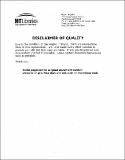Modeling the high resolution X-ray spectra from the relativistic jets of the X-ray binary SS 433
Author(s)
Lopez, Laura Ann, 1982-
DownloadFull printable version (2.431Mb)
Other Contributors
Massachusetts Institute of Technology. Dept. of Physics.
Advisor
Herman L. Marshall and Claude R. Canizares.
Terms of use
Metadata
Show full item recordAbstract
We test the physical model of the relativistic jets in the galactic X-ray binary SS 433 that was proposed by Marshall et al. 2002 (Paper I) using additional observations from the Chandra High Energy Transmission Grating Spectrometer. These observations sample two new orbital/precessional phase combinations. In the observation near orbital phase zero, the H- and He-like Fe lines from both receding and approaching jets are comparably strong and unocculted while the He-like Si line of the receding jet is significantly weaker than that of the approaching jet. This observation indicates the cooler parts of the jet are eclipsed by the companion. The spectrum from this observation has broader emission lines than obtained in Paper I; the opening angle of the jet is 2.70⁰ [plus-minus] 0.32⁰, double the previous Paper I result of 1.22⁰ [plus-minus] 0.06⁰. This result indicates the jet base may be five times smaller than the previous observation, with a jet launch radius of 21.3 [plus-minus] 3.1 Schwarzschild radii. Using the optical results presented by Gies et al. 2002, along with the length of the unobscured portion of the receding jet determined using a physical model of the X-ray spectrum, we calculate the radius of the companion to be 9.1 [plus-minus] 1.0 Rsun, about one third of the Roche lobe radius. For a main sequence star, this result corresponds to a companion mass of 29 [plus-minus] 7 Msun giving a primary source mass of 16 [plus-minus] 4 Msun This calculation indicates the compact object is a black hole, and accretion occurs through a wind process.
Description
Thesis (S.B.)--Massachusetts Institute of Technology, Dept. of Physics, 2004. Includes bibliographical references (leaves 59-62).
Date issued
2004Department
Massachusetts Institute of Technology. Department of PhysicsPublisher
Massachusetts Institute of Technology
Keywords
Physics.